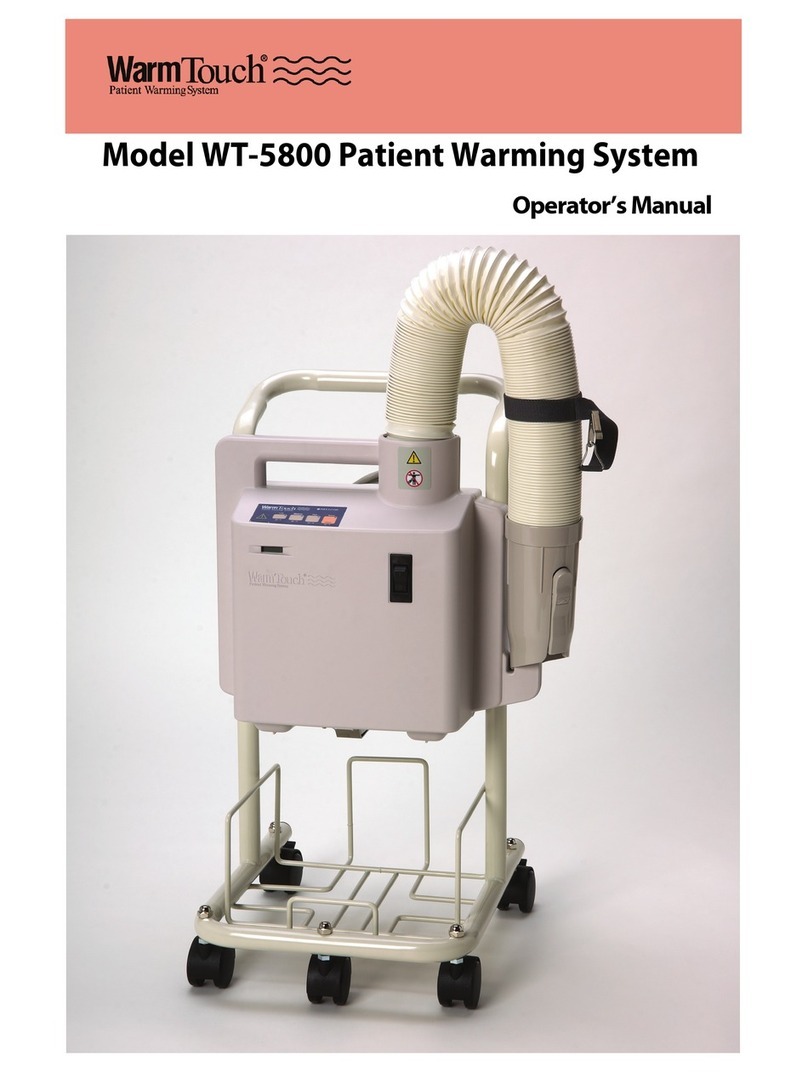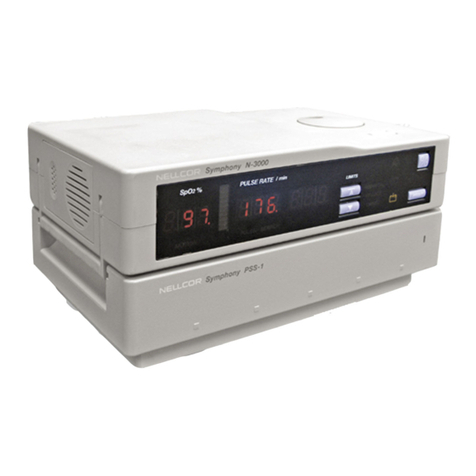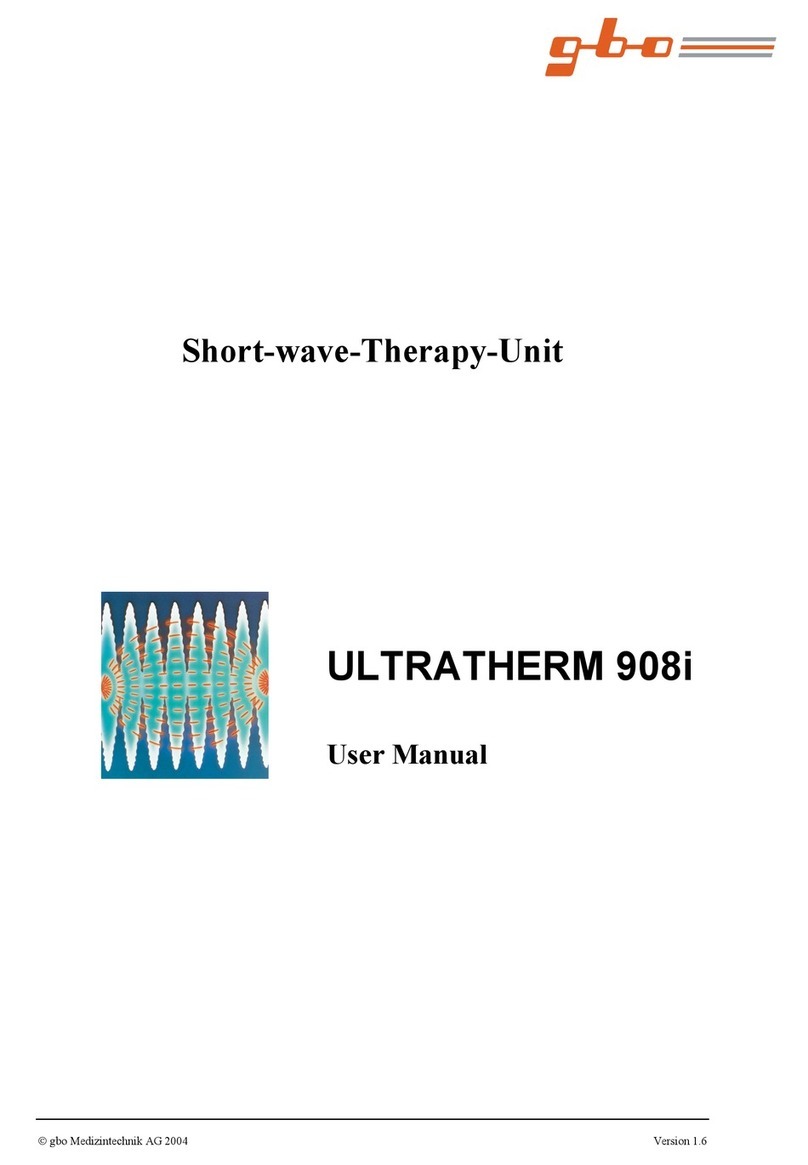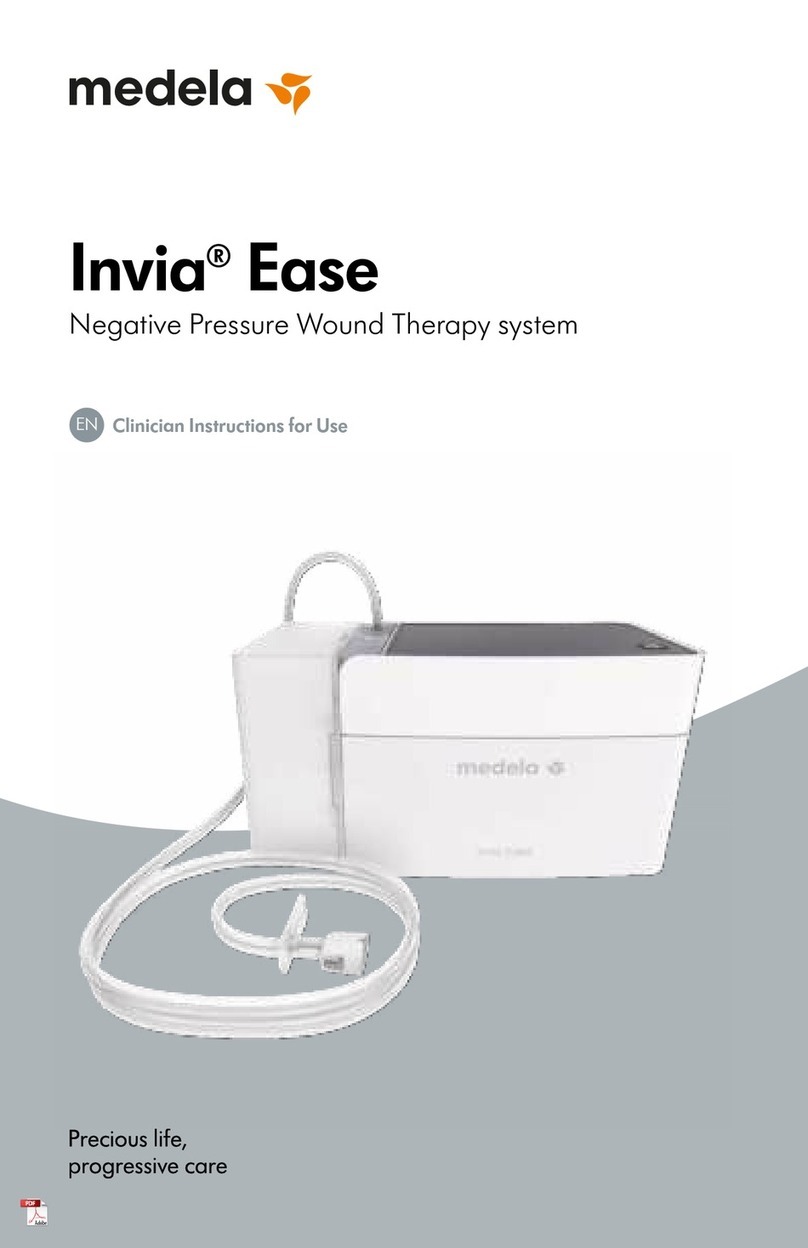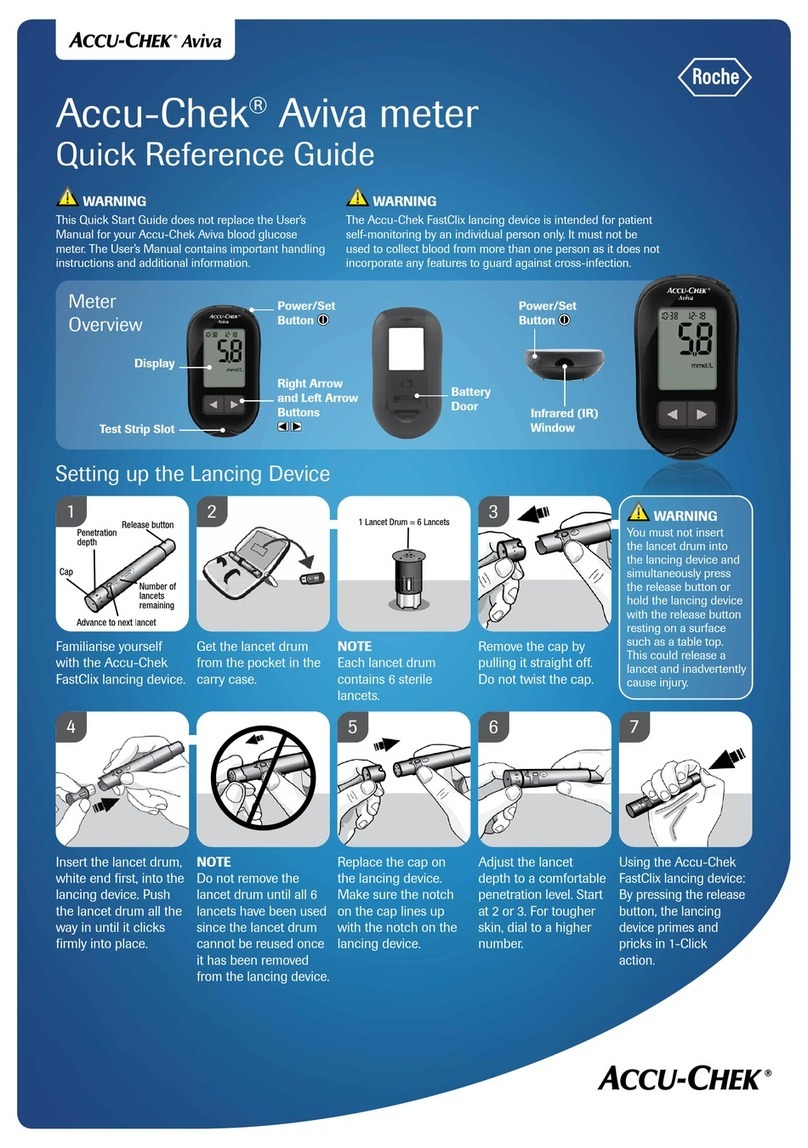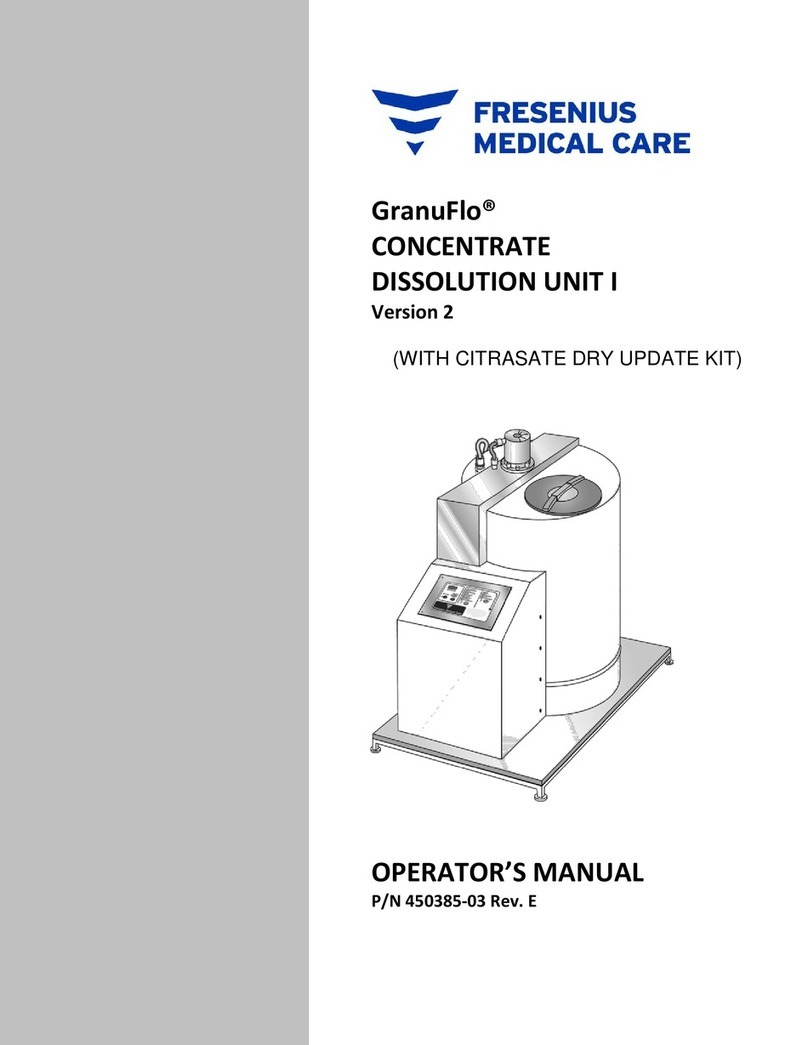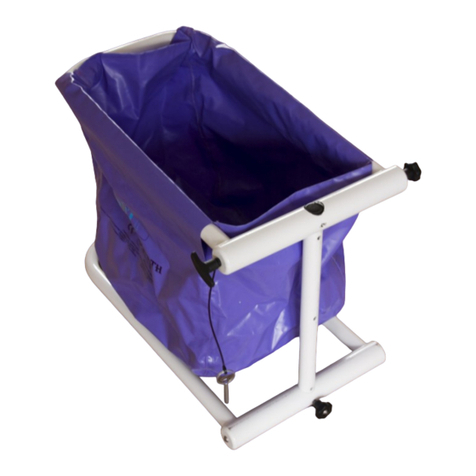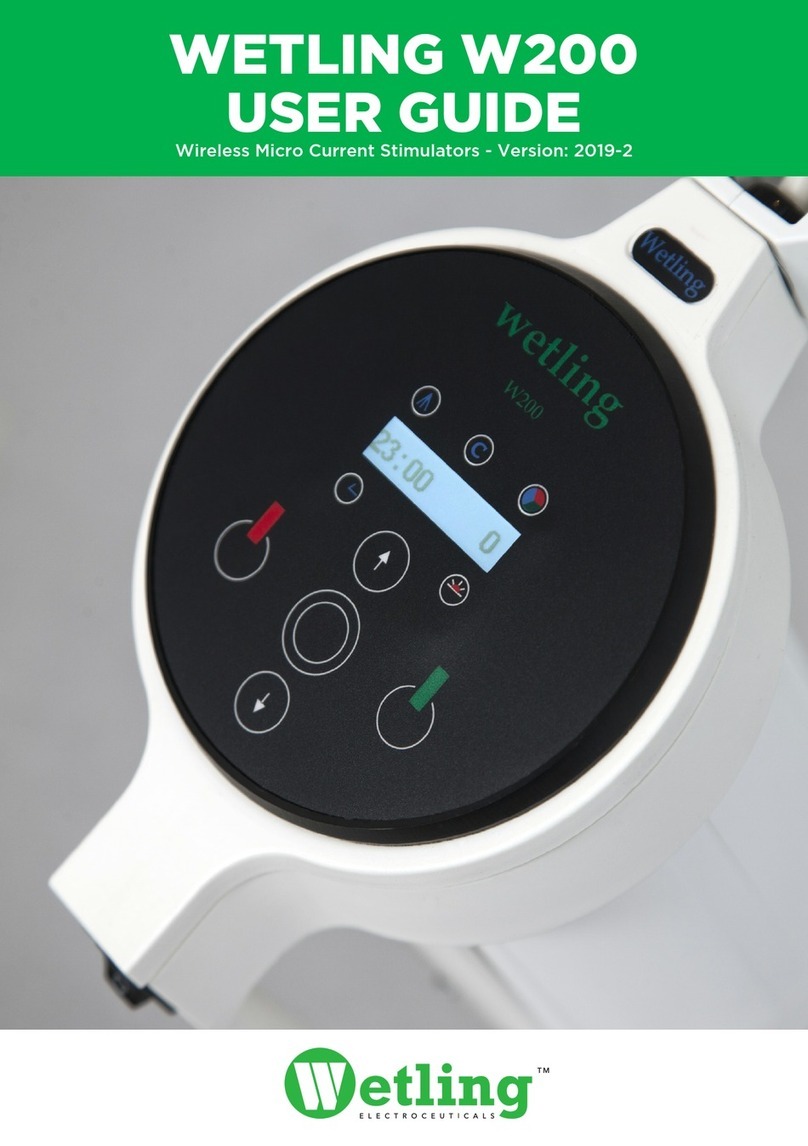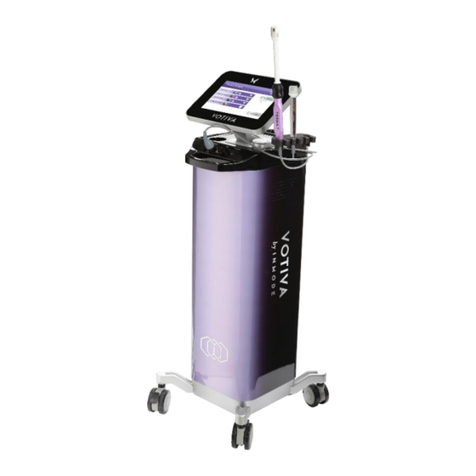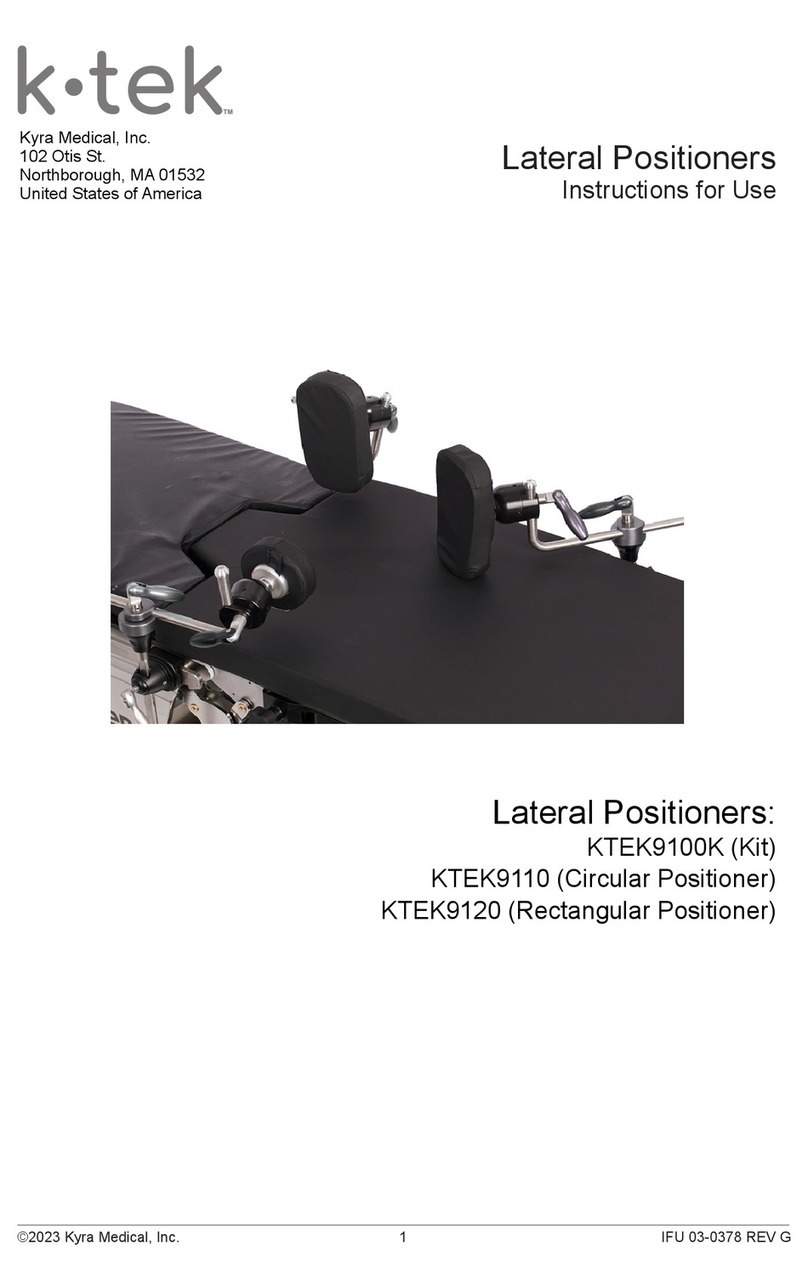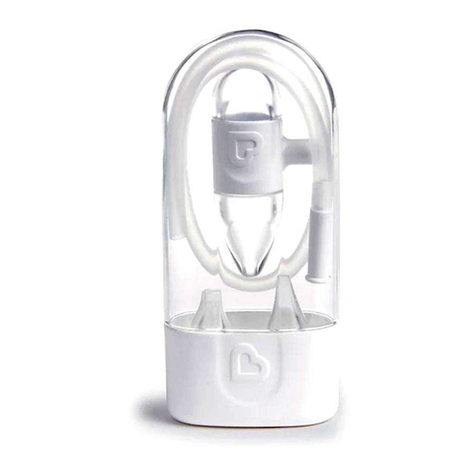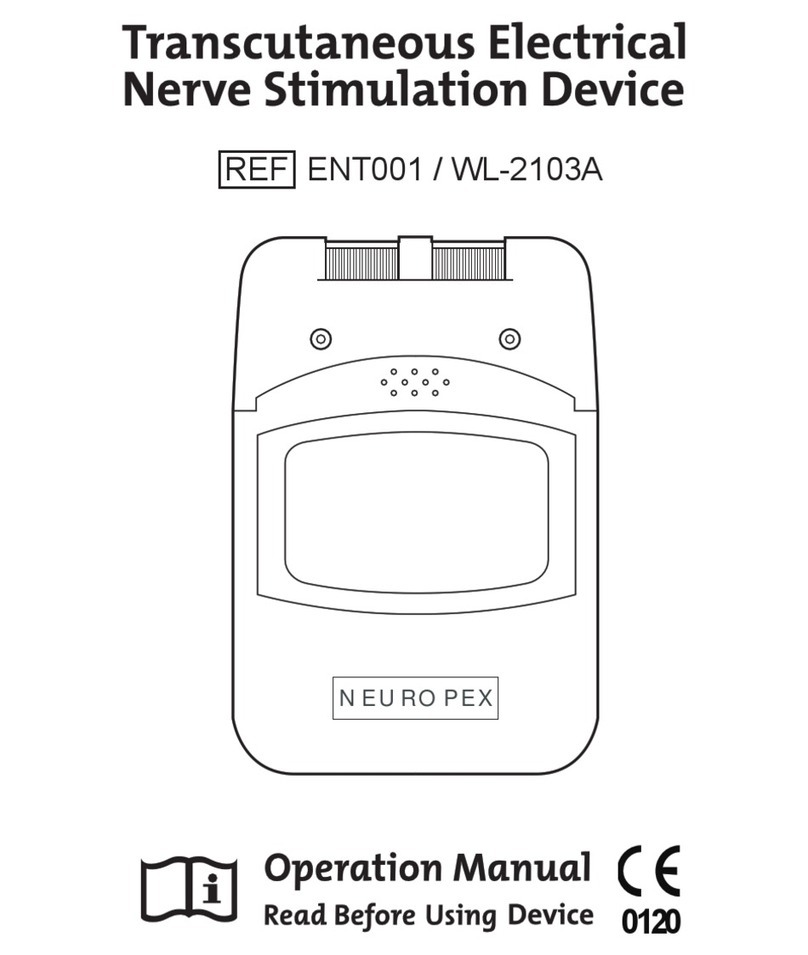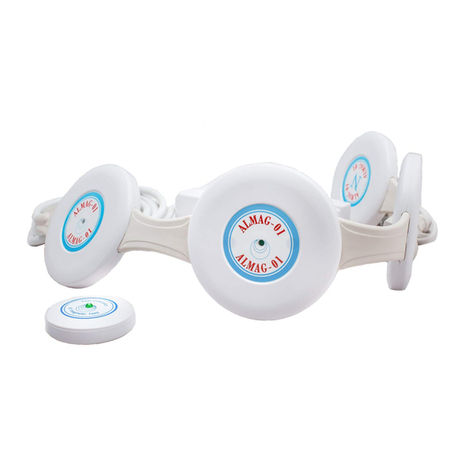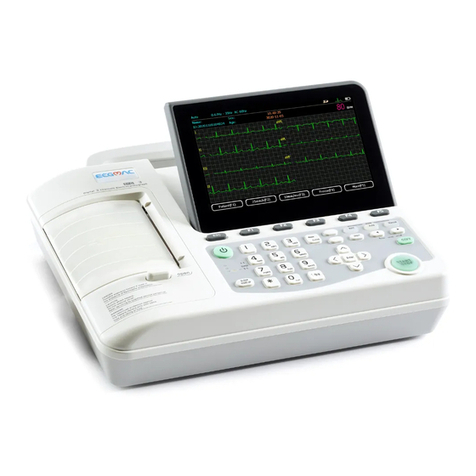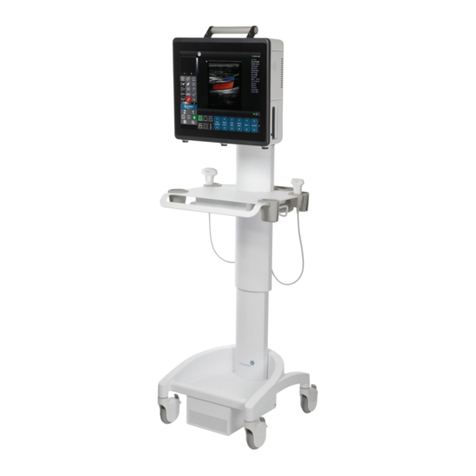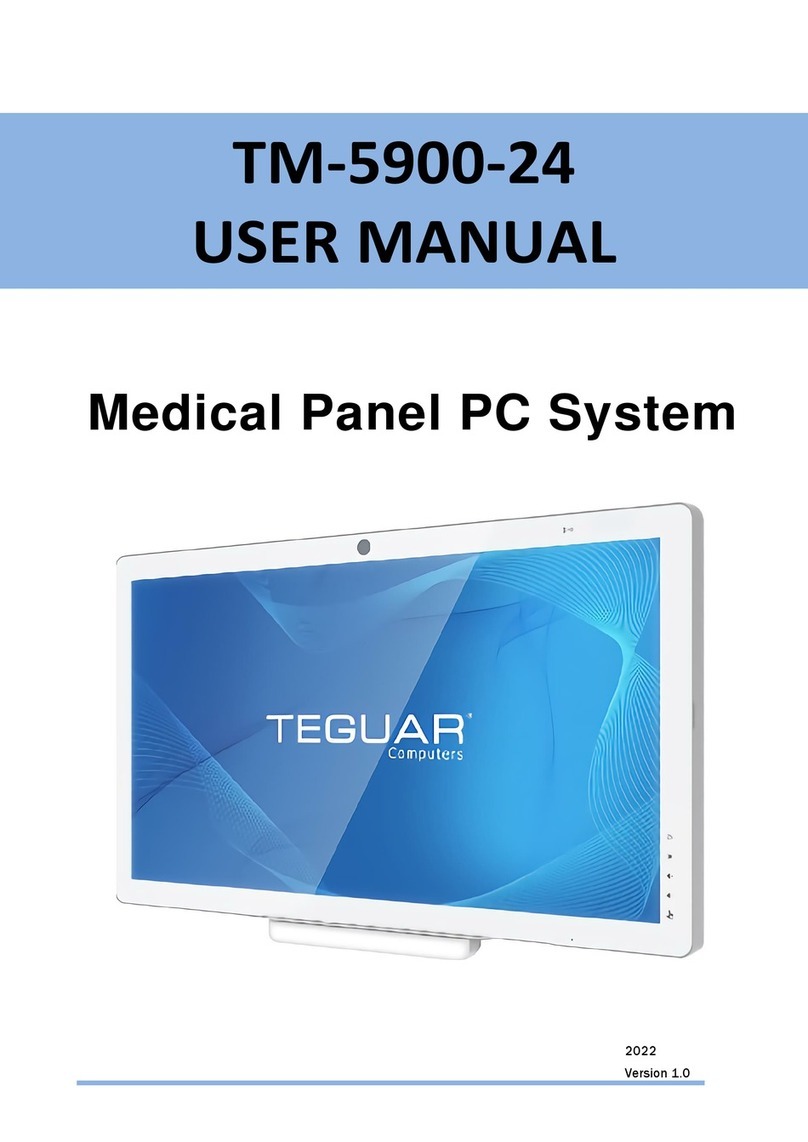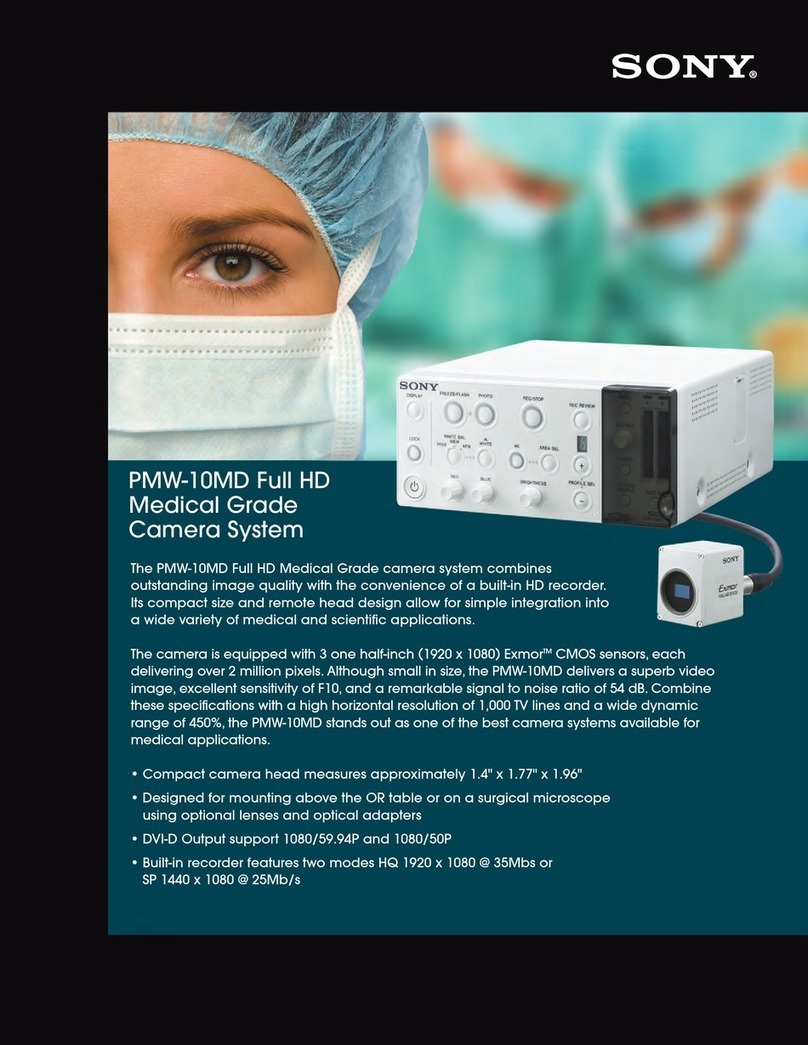NELLCOR PURITAN BENNETT Symphony N-3000 User manual

To contact Nellcor Puritan Bennett’s representative: In the United States, call 1-800-NELLCOR or 510 463-4000;
outside the United States, call your local Nellcor Puritan Bennett representative.
Caution: Federal law (U.S.) restricts this device to sale by or on the order of a physician.
0123
© 1996 Nellcor Puritan Bennett Incorporated. All rights reserved. 034129A-0296
SERVICE MANUAL
Nellcor
Symphony
™
N-3000 Pulse Oximeter

Corporate Headquarters
Nellcor Puritan Bennett Inc.
4280 Hacienda Drive
Pleasanton, California 94588 U.S.A.
Tel. 510 463-4000 or
1-800-NELLCOR
Fax 510 463-4420
U.S. Service Repair Center
Nellcor Puritan Bennett Inc.
2391 Fenton Street
Chula Vista, California 91914
U.S.A.
Tel. 619 482-5000
European Office
Nellcor Puritan Bennett Europe BV
Hambakenwetering 1
5231 DD ’s-Hertogenbosch
The Netherlands
Tel. +31.73.6485200
Asia/Pacific Office
Nellcor Puritan Bennett HK Ltd.
Room 1602 Evergo House
38 Gloucester Road
Wanchai
Hong Kong
Tel. +852.2529.0363
Regional/Local Offices
Nellcor Puritan Bennett UK Ltd.
10, Talisman Business Centre
London Road
Bicester
Oxfordshire OX6 0JX
United Kingdom
Tel. +44.1869.322700
Nellcor Puritan Bennett Belgium NV/SA
Interleuvenlaan 62/8, Zone 2
B-3001 Heverlee
Belgium
Tel. +32.16.400467
Nellcor Puritan Bennett France Sarl
21 rue Albert Calmette
78353 Jouy-en-Josas Cedex
France
Tel. +33.1.34.63.06.00
Nellcor Puritan Bennett Germany GmbH
Black-&-Decker-Strasse 28
65510 Idstein
Germany
Tel. +49.6126.5930
Nellcor Puritan Bennett Italia Srl
Via dei Tulipani, 3
20090 Pieve Emanuele (MI)
Italy
Tel. +39.2.90786404
To obtain information about a warranty, if any, for this product, contact Nellcor
Puritan Bennett Technical Services or your local Nellcor Puritan Bennett
representative.
Nellcor Puritan Bennett, Durasensor, Nellcor Symphony, Oxisensor II, and the Nellcor
Puritan Bennett knob configuration are trademarks of Nellcor Puritan Bennett
Incorporated.
Covered by one or more of the following U.S. Patents and foreign equivalents:
4,621,643; 4,653,498; 4,700,708; 4,770,179; 4,869,254; 5,078,136; and 5,351,685.

iii
TABLE OF CONTENTS
List of Figures
List of Tables
Section 1: Introduction
................................................................................ 1-1
1.1 Manual Overview........................................................................... 1-1
1.2 Warnings, Cautions, And Notes .................................................... 1-1
1.2.1 Warning............................................................................ 1-1
1.2.2 Caution............................................................................. 1-1
1.2.3 Note.................................................................................. 1-1
1.3 N-3000 Pulse Oximeter Description .............................................. 1-1
1.4 Related Documents....................................................................... 1-2
Section 2: Routine Maintenance
................................................................. 2-1
2.1 Cleaning ........................................................................................ 2-1
2.2 Periodic Safety and Functional Checks......................................... 2-1
2.3 Batteries ........................................................................................ 2-1
Section 3: Performance Verification
........................................................... 3-1
3.1 Introduction.................................................................................... 3-1
3.2 Equipment Needed........................................................................ 3-1
3.3 Performance Tests........................................................................ 3-1
3.3.1 Battery Operation Test..................................................... 3-1
3.3.2 Battery Charge................................................................. 3-2
3.3.3 Power-up Tests................................................................ 3-3
3.3.3.1 Power-On Self-Test ......................................................... 3-3
3.3.3.2 Adult Power-On Defaults and Alarm Limit Ranges .......... 3-4
3.3.3.3 Neonate Power-On Defaults and Alarm Limit Ranges..... 3-5
3.3.4 Operation with a Pulse Oximeter Tester .......................... 3-6
3.3.4.1 Alarms.............................................................................. 3-6
3.3.4.2 Alarm Silence................................................................... 3-7
3.3.4.3 Alarm Volume Control...................................................... 3-8
3.3.4.4 Pulse Tone Volume Control............................................. 3-8
3.3.4.5 Dynamic Operating Range............................................... 3-8
3.3.5 Normal Operation............................................................. 3-10
3.3.5.1 LED Excitation Test ......................................................... 3-10
3.3.5.2 Operation with a Live Subject .......................................... 3-10
3.3.5.3 Serial Interface Test......................................................... 3-11
3.4 Safety Tests .................................................................................. 3-12
3.4.1 Ground Integrity ............................................................... 3-13
3.4.2 Electrical Leakage............................................................ 3-13
3.4.2.1 Chassis Source Current................................................... 3-13
3.4.2.2 Patient Source Current .................................................... 3-14
3.4.2.3 Patient Sink Current......................................................... 3-14
3.5 SpO2Tests.................................................................................... 3-15
3.5.1 RCAL Circuit Test ............................................................ 3-15
3.5.2 LED Drive Tests............................................................... 3-15
3.6 Piezo Speaker Test....................................................................... 3-17
Section 4: Configuration Mode, Service Mode,
and Alarm Active Function
.................................................................... 4-1
4.1 Introduction.................................................................................... 4-1
4.2 Configuration Mode....................................................................... 4-1
4.2.1 Adult/Neonatal Mode Default ........................................... 4-2
4.2.2 Default SpO2Upper Alarm Limit ...................................... 4-3
4.2.3 Default SpO2Lower Alarm Limit ...................................... 4-3

Table of Contents
iv
4.2.4 Default Pulse Rate Upper Alarm Limit ............................. 4-3
4.2.5 Default Pulse Rate Lower Alarm Limit ............................. 4-4
4.2.6 Default Alarm Volume ...................................................... 4-4
4.2.7 Default Alarm Silence Duration........................................ 4-4
4.2.8 Configuration Menu.......................................................... 4-5
4.2.8.1 Pulse Tone Volume.......................................................... 4-5
4.2.8.2 UIF Software Version Report ........................................... 4-6
4.2.8.3 SpO2Software Version Report ........................................ 4-6
4.2.8.4 Set Serial Port Baud Rate................................................ 4-6
4.2.8.5 Trend Type....................................................................... 4-6
4.2.8.6 Reset to Factory Defaults ................................................ 4-7
4.3 Service Mode................................................................................. 4-7
4.3.1 Menu Item 1: Software Version Report ............................ 4-10
4.3.2 Menu Item 2: Knob and Lamp Test.................................. 4-10
4.3.3 Menu Item 3: Button Test................................................. 4-10
4.3.4 Menu Item 4: Speaker Test.............................................. 4-11
4.3.5 Menu Item 5: Internal Configuration Code (ICC) Report .. 4-11
4.3.6 Menu Item 6: Total Operating Hours Report .................... 4-12
4.3.7 Menu Items 7-16: Error Log Record Report..................... 4-12
4.3.8 Menu Item 17: Instrument Identification (IID) Report ....... 4-13
4.3.9 Menu Item 18: Power Status............................................ 4-13
4.3.10 Menu Item 19: Persistent Time Sense Report................. 4-14
4.3.11 Menu Item 20: Reset to Factory Defaults......................... 4-14
4.3.12 Menu Item 21: Initial Cluster Instrument Number Report. 4-14
4.3.13 Menu Item 22: Enable/Disable Latching Alarms .............. 4-15
4.3.14 Menu Item 23: Enable/Disable Alarm Silence Reminder . 4-15
4.3.15 Menu Item 25: Dump EEPROM Data .............................. 4-15
4.3.16 Menu Item 28: Enable/Disable Battery Charge Circuit..... 4-16
4.3.17 Menu Item 29: Instrument Compatibility Report............... 4-16
4.3.18 Menu Item 30: SpO2RCAL Report.................................. 4-17
4.3.19 Menu Item 31: SpO2IR and Red Offset Report............... 4-17
4.3.20 Menu Item 32: SpO2IR and Red Signals Report ............ 4-17
4.3.21 Menu Item 33: SpO2IR LED Drive Test........................... 4-18
4.3.22 Menu Item 34: SpO2Red LED Drive Test ....................... 4-18
4.3.23 Menu Item 35: SpO2DM-Gain Test ................................. 4-19
4.3.24 Menu Item 36: SpO2P-Gain Test.................................... 4-19
4.3.25 Menu Item 37: Set SpO2Analog Test Mode.................... 4-20
4.3.26 Menu Item 38: SpO2A/D Cal Line Test........................... 4-20
4.3.27 Menu Item 39: SpO2Enable Automatic Operation .......... 4-21
4.3.28 Menu Item 60: Set Serial Port Baud Rate........................ 4-21
4.3.29 Menu Item 61: Serial Port Loop Back Test ...................... 4-22
4.3.30 Menu Item 62: Serial Port Transmit Test ......................... 4-22
4.4 Alarm Active Function.................................................................... 4-23
Section 5: Troubleshooting
......................................................................... 5-1
5.1 Introduction.................................................................................... 5-1
5.2 How to Use this Section ................................................................ 5-1
5.3 Who Should Perform Repairs........................................................ 5-1
5.4 Replacement Level Supported...................................................... 5-1
5.5 Obtaining Replacement Parts ....................................................... 5-1
5.6 Troubleshooting Guide.................................................................. 5-2
5.6.1 Power............................................................................... 5-3
5.6.2 Error Codes...................................................................... 5-4
5.6.2.1 User-Correctable Error Codes ......................................... 5-4
5.6.2.2 Failure Error Codes.......................................................... 5-4
5.6.3 Buttons/Knob.................................................................... 5-7

Table of Contents
v
5.6.4 Display/Alarms ................................................................. 5-8
5.6.5 Operational Performance................................................. 5-9
5.6.6 Stacked Operation ........................................................... 5-10
5.6.7 Serial Port ........................................................................ 5-11
Section 6: Disassembly Guide
.................................................................... 6-1
6.1 Introduction.................................................................................... 6-1
6.2 Removing the Battery.................................................................... 6-1
6.3 Battery Replacement..................................................................... 6-3
6.4 Fuse Replacement ........................................................................ 6-4
6.5 Monitor Disassembly ..................................................................... 6-4
6.5.1 Communications Board Switch Settings .......................... 6-5
6.6 Removing the Alarm Speaker ....................................................... 6-6
6.7 Removing the SpO2PCB and SpO2Controller PCB .................... 6-7
6.8 Removing the Communications PCB............................................ 6-8
6.9 Removing the UIF PCB and Display PCB..................................... 6-8
6.10 Control Knob Assembly Replacement........................................... 6-10
6.11 Lithium Battery Replacement ........................................................ 6-11
6.12 Reassembly................................................................................... 6-11
Section 7: Spare Parts
................................................................................. 7-1
7.1 Introduction.................................................................................... 7-1
Section 8: Packing for Shipment
................................................................ 8-1
8.1 General Instructions ...................................................................... 8-1
8.2 Repacking in Original Carton ........................................................ 8-1
8.3 Repacking in a Different Carton .................................................... 8-2
Section 9: Specifications
............................................................................. 9-1
9.1 General.......................................................................................... 9-1
9.2 Electrical........................................................................................ 9-1
9.3 Physical Characteristics ................................................................ 9-2
9.4 Environmental ............................................................................... 9-2
9.5 Alarms ........................................................................................... 9-2
9.6 Factory Default Settings ................................................................ 9-2
9.7 Performance.................................................................................. 9-3
Appendix
....................................................................................................... A-1
A1 Integrity Tests................................................................................ A-1
A2 Error Types.................................................................................... A-2
A3 User Correctable Error Codes....................................................... A-3
A4 Failure Error Codes....................................................................... A-3
A5 Internally Corrected Error Codes................................................... A-4
Technical Supplement
................................................................................. S-1
S1 Introduction.................................................................................... S-1
S2 Oximetry Overview........................................................................ S-1
S2.1 Automatic Calibration....................................................... S-1
S2.2 Functional Versus Fractional Saturation.......................... S-2
S2.3 Measured Versus Calculated Saturation ......................... S-2
S3 Stackbus Interconnect................................................................... S-2
S4 Circuit Analysis.............................................................................. S-3
S4.1 Functional Overview ........................................................ S-3
S4.2 Circuit Description............................................................ S-4
S4.2.1 SpO2Module .................................................................... S-4
S4.2.2 UIF Module ...................................................................... S-7
S4.2.3 SpO2Controller............................................................... S-15
S4.2.4 Communications Sub Module ......................................... S-17
S4.2.5 Display Board.................................................................. S-19
S5 Schematic Diagrams .................................................................... S-20

Table of Contents
vi
LIST OF FIGURES
1-1 N-3000 Front Panel (North American)............................................... 1-2
3-1 Self-Test Display ............................................................................... 3-3
3-2 Serial Port Interface........................................................................... 3-11
3-3 N-3000 to External PC Connections.................................................. 3-12
3-4 Battery Cover Removal...................................................................... 3-17
3-5 Speaker Test...................................................................................... 3-18
4-1 Serial Port Pin Locations.................................................................... 4-23
6-1 Battery Replacement ......................................................................... 6-2
6-2 Removing the Battery........................................................................ 6-3
6-3 N-3000 Fuses .................................................................................... 6-4
6-4 N-3000 Corner Screws ...................................................................... 6-4
6-5 Opening the N-3000 Monitor ............................................................. 6-5
6-6 Handle, Left Side Panel, and Speaker Disassembly ......................... 6-6
6-7 Rear Panel and SpO2Module Disassembly...................................... 6-7
6-8 Communications PCB Removal ........................................................ 6-8
6-9 Display PCBand UIF Board Disassembly ........................................... 6-9
6-10 Knob Encoder Disassembly............................................................... 6-10
6-11 Knob Disassembly ............................................................................. 6-10
7-1 N-3000 Expanded View..................................................................... 7-2
8-1 Repacking the N-3000....................................................................... 8-1
S2-1 Oxyhemoglobin Dissociation Curve................................................... S-2
S4-1 N-3000 Functional Block Diagram..................................................... S-4
S4-2 Timing Diagram ................................................................................. S-5
S4-3 Internal/External Stackbus Connections............................................ S-11
S4-4 Communications Submodule Block Diagram .................................... S-17
S4-5 Display Board Block Diagram............................................................ S-19
LIST OF TABLES
3-1 Serial Port Voltages............................................................................ 3-12
4-1 Configuration Mode Menu.................................................................. 4-2
4-2 Configuration Menu............................................................................ 4-5
4-3 Service Mode Steady State - Main Menu........................................... 4-9
5-1 Problem Categories............................................................................ 5-2
5-2 Power Problems................................................................................. 5-3
5-3 N-3000 Failure Error Codes ............................................................... 5-5
5-4 Buttons/Knob Problems...................................................................... 5-7
5-5 Display/Alarms Problems ................................................................... 5-8
5-6 Operational Performance Problems ................................................... 5-9
5-7 Stack Problems .................................................................................. 5-10
5-8 Serial Port Problems .......................................................................... 5-11
A-1 Error Types......................................................................................... A-2
A-2 N-3000 User Correctable Error Codes ............................................... A-3
A-3 N-3000 Failure Error Codes ............................................................... A-3
A-4 N-3000 Internally Corrected Error Codes........................................... A-4
S4-1 J13 Inter Stack Connector................................................................. S-8
S4-2 J8 Connector ..................................................................................... S-13
S4-3 J12, J22 Inter Module Connector ...................................................... S-14
S4-4 J5 Display Connector ........................................................................ S-14
S4-5 J2 Speaker Connector....................................................................... S-15
S4-6 J3 Knob Connector............................................................................ S-15

1-1
SECTION 1: INTRODUCTION
1.1 Manual Overview
1.2 Warnings, Cautions, and Notes
1.3 N-3000 Pulse Oximeter Description
1.4 Related Documents
1.1 MANUAL OVERVIEW
This manual contains information for servicing the Nellcor Symphony
model N-3000 pulse oximeter. Only qualified service personnel should service
this product. Before servicing the N-3000, read the operator’s manual
carefully for a thorough understanding of operation.
1.2 WARNINGS, CAUTIONS, AND NOTES
This manual uses three terms that are important for proper operation of the
monitor: Warning, Caution, and Note.
1.2.1 Warning
A warning precedes an action that may result in injury or death to the
patient or user. Warnings are boxed and highlighted in boldface type.
1.2.2 Caution
A caution precedes an action that may result in damage to, or malfunction of,
the monitor. Cautions are highlighted in boldface type.
1.2.3 Note
A note gives information that requires special attention.
1.3 N-3000 PULSE OXIMETER DESCRIPTION
The Nellcor Symphony N-3000 pulse oximeter is intended for continuous
noninvasive monitoring of functional oxygen saturation and pulse rate for
adult, pediatric, and neonatal patients in a hospital environment. It may be
used during hospital transport and in protected mobile environments such as
ambulances and helicopters when powered by its internal battery and
protected from excessive moisture, such as direct exposure to rain.
The N-3000 can operate as a standalone monitor or it can be connected to
(stacked with) the N-3100 blood pressure monitor.
The physical and operational characteristics of the monitor are described in
the operator’s manual and Section 9, Specifications, of this manual.
Figure 1-1 depicts the North American front panel of the N-3000 and the
names of its displays and controls.

Section 1: Introduction
1-2
SpO
2
%
Symphony N-3000
1 2 3 7
68 9
101112
1314151617181920
4 5
PULSE RATE /
min
LIMITS
PRINT
PULSE SEARCH LEADS OFFMOTION
NEONATAL
RF LOCK
LINKED
Figure 1-1: N-3000 Front Panel (North American)
1. SpO2% display 11. PRINT button
2. PULSE AMPLITUDE indicator 12. BATTERY IN USE/BATTERY LOW indicator
3. ECG HEART RATE indicator * 13. BATTERY CHARGING indicator
4. PULSE RATE display 14. LINKED indicator*
5. AUXILIARY display 15. RF LOCKED indicator*
6. NEONATAL MODE indicator 16. LOWER ALARM LIMIT button
7. AUDIBLE ALARM OFF indicator 17. UPPER ALARM LIMIT button
8. ON/STANDBY button 18. LEADS OFF indicator*
9. POWER ON indicator 19. PULSE SEARCH indicator
10. STACKED indicator 20. PATIENT MOTION indicator
* Not used on this model
1.4 RELATED DOCUMENTS
To perform test and troubleshooting procedures and to understand the
principles of operation and circuit analysis sections of this manual, you must
know how to operate the monitor. Refer to the N-3000 operator’s manual. To
understand the various Nellcor Puritan Bennett sensors that work with the
monitor, refer to the individual sensor directions for use.

2-1
SECTION 2: ROUTINE MAINTENANCE
2.1 Cleaning
2.2 Periodic Safety and Functional Checks
2.3 Batteries
2.1 CLEANING
Caution: Do not immerse the N-3000 or its accessories in liquid or use
caustic or abrasive cleaners. Do not spray or pour any liquid on the
monitor or its accessories.
To clean the N-3000, dampen a cloth with a commercial, nonabrasive cleaner
and wipe the instrument exterior surfaces lightly. Do not allow any liquids to
come in contact with the power connector, fuse holder, or switches. Do not
allow any liquids to penetrate connectors or openings in the instrument cover.
Wipe sensor extension cables with a damp cloth. For sensors, follow
individual directions for use.
2.2 PERIODIC SAFETY AND FUNCTIONAL CHECKS
The following safety checks should be performed by a qualified service
technician after any repair or opening of the case, upon return of the
instrument from any use outside your institution’s control, or every 2 years.
1. Inspect the exterior of the N-3000 and verify that there is no evidence of
damage. Refer to Section 5, Troubleshooting for repair. If the N-3000
cannot be repaired, contact Nellcor Puritan Bennett’s Technical Services
Department or your local Nellcor Puritan Bennett representative.
2. Inspect safety labels for legibility. If labels are not legible, contact
Nellcor Puritan Bennett’s Technical Services Department or your local
Nellcor Puritan Bennett representative.
3. Verify that the monitor performs properly as described in paragraph 3.3.
4. Perform the electrical safety tests detailed in paragraph 3.4. If the unit
fails these electrical safety tests, do not attempt to repair, contact Nellcor
Puritan Bennett’s Technical Services Department or your local Nellcor
Puritan Bennett representative.
5. Inspect fuse(s) for proper rating (F1: 1.0 Amp, 250 Volt, Slo-Blow and F2:
2.5 Amp, 250 Volt, Slo-Blow). If necessary, replace as described in
paragraph 6.4.
2.3 BATTERIES
Nellcor Puritan Bennett recommends replacing instrument batteries at least
every 2 years. To replace the batteries, refer to Section 6, Disassembly Guide.
If the N-3000 has been stored for more than 30 days, charge the battery as
described in paragraph 3.3.2. A fully discharged battery requires a 14 hour
charge for a full charge. A 6-hour charge is required for 1 hour of operating
time.


3-1
SECTION 3: PERFORMANCE VERIFICATION
3.1 Introduction
3.2 Equipment Needed
3.3 Performance Tests
3.4 Safety Tests
3.5 SpO2Tests
3.6 Piezo Speaker Test
3.1 INTRODUCTION
This section discusses the tests used to verify performance following
troubleshooting and repairs. All tests are accomplished through the control
panel.
3.2 EQUIPMENT NEEDED
Equipment Description
AC Power Adapter Nellcor Puritan Bennett model
SPS-N or SPS-N1
Safety Analyzer Must meet current AAMI
specifications
Sensor Cable SCP-10
Digital Multimeter (DMM) Fluke Model 87 or equivalent
Durasensor®Oxygen Transducer DS-100A
Serial Interface Cable EIA-232 cable (optional)
Connector Adapter 6-pin, miniature
Oxisensor®II Oxygen Transducer D-25
Pulse Oximeter Tester SRC-2
3.3 PERFORMANCE TESTS
Note: The battery operation and battery charge tests should be performed
before monitor repairs whenever the battery is suspected of being a
source of the problems. All other tests should be performed following
monitor repairs. Before performing the battery operation test, ensure
that the battery is fully charged (Paragraph 3.3.2).
3.3.1 Battery Operation Test
The monitor is specified to operate on battery power a minimum of 4 hours.
(This time may decrease if the N-3000 is operating in the stacked
configuration.)
1. Connect the Nellcor Puritan Bennett SRC-2 pulse oximeter tester to the
monitor.
2. Ensure that the monitor is not connected to AC power.

Section 3: Performance Verification
3-2
3. With the N-3000 turned off, press the ON/STANDBY button and verify
that the BATTERY IN USE/BATTERY LOW indicator lights after the
power-on self-test is completed.
4. The monitor must operate for at least 4 hours.
5. The BATTERY IN USE/BATTERY LOW indicator will start to flash
about 15 minutes before the battery fully discharges.
6. Allow the monitor to operate until it automatically powers down due to
the low battery.
7. If the monitor passes this test, immediately recharge the battery
(Paragraph 3.3.2, steps 1 - 3).
3.3.2 Battery Charge
Perform this procedure to fully charge the battery or after the Battery
Operation Test (Paragraph 3.3.1). This procedure should be performed, if
possible, before repair work is attempted.
1. Connect the monitor to an AC power source using the external power
supply.
2. Verify that the monitor is off and that the BATTERY CHARGING
indicator is lit.
3. Charge the battery for at least 14 hours.
Note: The BATTERY CHARGING indicator is timed to go out when
the N-3000 has been turned off and connected to AC power for
14 hours. Likewise, if the monitor is turned on and connected to
AC power for 14 hours (with no power interruptions), the
indicator goes out.
An illuminated BATTERY CHARGING indicator is not
necessarily an indication that the battery contains less than a
full charge. It is merely used as a timer to indicate that the
battery has been continuously charging for less than 14 hours.
4. If unsure whether the battery is functioning properly, perform the
procedure in Paragraph 3.3.1 “Battery Operation Test”.
5. Repeat this procedure (3.3.2 “Battery Charge”) through step 3 before
returning the monitor to service.

Section 3: Performance Verification
3-3
3.3.3 Power-up Tests
The power-up tests (3.3.3.1 through 3.3.3.3) verify the following monitor
functions:
• Power-On Self-Test
• Adult Power-On Defaults and Alarm Limit Ranges
• Neonate Power-On Defaults and Alarm Limit Ranges
3.3.3.1 Power-On Self-Test
1. Connect the monitor to an AC power source using the external power
supply and verify that the BATTERY CHARGING indicator is lit.
2. Do not connect any sensor cables to the monitor.
3. Observe the monitor front panel. With the monitor off, press the
ON/STANDBY button. To successfully complete the self-test, the monitor
must perform the following sequence.
a. The monitor emits three consecutively higher pitched beeps.
b. All indicators light for a few seconds as illustrated in Figure 3-1.
Verify that the SpO2% (left-most display), PULSE RATE (middle),
and AUXILIARY (right) displays all indicate “8.8.8.”.
SpO
2
%
Symphony N-3000
PULSE RATE /
min
LIMITS
PRINT
PULSE SEARCH LEADS OFFMOTION
NEONATAL
RF LOCK
LINKED
Figure 3-1: Self-Test Display
c. All displays turn off momentarily.
d. Digital displays individually light in a scanning, or firefly, test
pattern while the test is taking place.
e. A single, 1-second beep is produced and all displays again illuminate
momentarily, indicating that the automatic power-on self-test is
complete. The beep may sound before all the displays have lit in the
scanning sequence.
f. The POWER ON indicator and the BATTERY CHARGING indicator
are illuminated. The SpO2%, PULSE RATE, and AUXILIARY
displays are blank. (If an SpO2sensor cable and sensor were
connected, “0” would be displayed in both the SpO2% and PULSE
RATE displays.) This is referred to as the normal mode steady state.
g. Press and hold the NEW PATIENT/NEONATAL button (located on
the rear panel) for 3 seconds until you hear three beeps, indicating
that stored patient data is cleared.

Section 3: Performance Verification
3-4
3.3.3.2 Adult Power-On Defaults and Alarm Limit Ranges
Note: This paragraph and paragraph 3.3.3.3 are written using Nellcor
Puritan Bennett factory-set defaults. If your institution has
preconfigured custom defaults, those values will be displayed.
Factory defaults can be reset using the service mode procedure
described in paragraph 4.3.11, Menu Item 20, Reset to Factory
Defaults, or the configuration mode procedure described in
paragraph 4.2.8.6.
When observing or changing default limits, a 3-second timeout is in
effect, that is, if no action is taken within 3 seconds, the monitor
automatically returns to the normal mode steady state.
1. Ensure that the monitor is on. Press and release the UPPER ALARM
LIMIT button. Verify that the monitor emits a single beep and the
SpO2% display indicates an alarm limit of “100” for 3 seconds. Verify
that the other displays indicate a single bar at the top of each window
while the “100” is displayed.
SpO
2
% PULSE RATE/ min
At the end of the 3 seconds, the displays indicate dashes (normal mode
steady state).
2. Press and release the UPPER ALARM LIMIT button. Begin rotating the
control knob counterclockwise (CCW) within 3 seconds. Verify that the
SpO2% display reduces to a minimum of “85.”.
Note: A decimal point in the display indicates that the alarm limits
have changed.
3. Press and release the LOWER ALARM LIMIT button. Verify that the
monitor emits a single beep and the SpO2% display indicates an alarm
limit of “85” for 3 seconds. Verify that the other displays indicate a single
bar at the bottom of each window while the “85” is displayed.
4. From the normal mode steady state, press and release the LOWER
ALARM LIMIT button. Begin rotating the control knob CCW within
3 seconds. Verify that the SpO2% display reduces to a minimum of “20”.
Rotate the control knob clockwise (CW) and verify that the SpO2%
display cannot be raised past the upper alarm limit setting of “85”.
5. Press the UPPER ALARM LIMIT button two times rapidly (twice within
3 seconds). Verify that the monitor emits two beeps and the PULSE
RATE display indicates an alarm limit of “170” for 3 seconds.
6. From the normal mode steady state, press the UPPER ALARM LIMIT
button two times rapidly. Begin rotating the control knob CCW within
3 seconds. Verify that the PULSE RATE display reduces to a minimum
of “40”.
7. Press the LOWER ALARM LIMIT button two times rapidly. Verify that
the PULSE RATE display indicates an alarm limit of “40” for 3 seconds.
8. From the normal mode steady state, press the LOWER ALARM LIMIT
button two times rapidly. Rotate the control knob CCW. Verify that the
PULSE RATE display reduces to a minimum of “30”.

Section 3: Performance Verification
3-5
9. Press the AUDIBLE ALARM OFF button (located on top of the N-3000)
and verify that the monitor emits a low-pitched beep when the button is
pressed.
10. Press the ON/STANDBY button to turn the monitor off. Verify that the
monitor emits three decreasing pitch beeps.
11. Observe the monitor front panel. Press the ON/STANDBY button. The
monitor performs the sequence described in paragraph 3.3.3.1 (Power-On
Self-Test), 3a through 3g.
12. Press and release the UPPER ALARM LIMIT button. Verify that the
SpO2% display indicates an alarm limit of “100”.
13. Press and release the LOWER ALARM LIMIT button. Verify that the
SpO2% display indicates an alarm limit of “85”.
14. Press the UPPER ALARM LIMIT button two times rapidly. Verify that
the PULSE RATE display indicates an alarm limit of “170”.
15. Press the LOWER ALARM LIMIT button two times rapidly. Verify that
the PULSE RATE display indicates an alarm limit of “40”.
16. Press the ON/STANDBY button to turn the monitor off.
3.3.3.3 Neonate Power-On Defaults and Alarm Limit Ranges
Note: When observing or changing default limits, a 3-second timeout is in
effect, that is, if no action is taken within 3 seconds, the monitor
automatically returns to the normal mode steady state.
1. Turn the monitor on.
2. Press the NEW PATIENT/NEONATAL button on the rear panel two
times rapidly (twice within 2 seconds).
3. Verify that the NEONATAL MODE indicator on the front panel is lit.
4. From the normal mode steady state, press and release the UPPER
ALARM LIMIT button. Verify that the SpO2% display indicates an
alarm limit of “95” for 3 seconds. Verify that the other displays indicate a
single bar at the top of each window while the “95” is displayed.
5. From the normal mode steady state, press and release the UPPER
ALARM LIMIT button. Begin rotating the control knob CCW within
3 seconds. Verify that the SpO2% display reduces to a minimum of “80”.
6. From the normal mode steady state, press and release the LOWER
ALARM LIMIT button. Verify that the SpO2% display indicates an
alarm limit of “80”. Verify that the other displays indicate a single bar at
the bottom of each window while the “80” is displayed.
7. From the normal mode steady state, press and release the LOWER
ALARM LIMIT button. Rotate the control knob CCW. Verify that the
SpO2% display reduces to a minimum of “20”. Rotate the knob CW to
verify that the lower alarm limit cannot be raised past the upper alarm
limit of 80.

Section 3: Performance Verification
3-6
8. Press the UPPER ALARM LIMIT button two times rapidly (twice within
3 seconds). Verify that the PULSE RATE display indicates an alarm
limit of “190”.
9. Press the LOWER ALARM LIMIT button twice rapidly. Verify that the
PULSE RATE display indicates an alarm limit of “90”.
10. Press the AUDIBLE ALARM OFF button and verify that the monitor
emits a beep when the button is pressed.
11. Press the ON/STANDBY button to turn the monitor off.
12. Press the ON/STANDBY button to turn the monitor on. The monitor
performs the sequence described in 3.3.3.1.
Note: The “NEO” indicator will not be lit.
13. Press and release the UPPER ALARM LIMIT button. Verify that the
SpO2% display indicates an alarm limit of “100”.
14. Press and release the LOWER ALARM LIMIT button. Verify that the
SpO2% display indicates an alarm limit of “85”.
15. Press the ON/STANDBY button to turn the monitor off.
This completes the power-up tests.
3.3.4 Operation with a Pulse Oximeter Tester
Operation with an SRC-2 pulse oximeter tester includes the following tests.
• 3.3.4.1 Alarms
• 3.3.4.2 Alarm Silence
• 3.3.4.3 Alarm Volume Control
• 3.3.4.4 Volume Control
• 3.3.4.5 Dynamic Operating Range
Note: This section is written using Nellcor Puritan Bennett factory-set
defaults. If your institution has preconfigured custom defaults, those
values will be displayed. Factory defaults can be reset using the
service mode procedure described in Paragraph 4.3.11, Menu Item
20, Reset to Factory Defaults, or the configuration mode procedure
described in paragraph 4.2.8.6.
3.3.4.1 Alarms
1. Connect the SRC-2 pulse oximeter tester to the sensor input cable and
connect the cable to the monitor. Set the SRC-2 as follows:
SWITCH POSITION
RATE 38
LIGHT LOW
MODULATION HIGH
MODE LOC/RCAL 63

Section 3: Performance Verification
3-7
2. Press and release the ON/STANDBY button to turn the monitor on. After
the normal power-up sequence, verify that the SpO2% and PULSE RATE
displays initially indicate zeroes.
Note: The pulse bar may occasionally indicate a step change as the
monitor is in the pulse search mode.
3. Verify the following monitor reaction:
a. The pulse bar begins to track the artificial pulse signal from the
SRC-2.
b. After at least five pulses, the monitor displays a saturation and
pulse rate within the following tolerances:
Oxygen Saturation Range 79 to 83%
Pulse Rate Range 37 to 39 bpm
c. The pulse “beep” will be heard.
d. The audio alarm will sound and both the SpO2% and PULSE RATE
display will flash, indicating both parameters have violated the
default alarm limits. To silence the alarm, continue with the
following paragraph.
3.3.4.2 Alarm Silence
After completing paragraph 3.3.4.1:
1. Press and hold the AUDIBLE ALARM OFF button on the top of the
monitor. The alarm is silenced. The PULSE RATE display indicates “60”
and the AUXILIARY display indicates “SEC” while the AUDIBLE
ALARM OFF button is pressed.
2. Release the AUDIBLE ALARM OFF button. Verify the following:
a. The alarm remains silenced.
b. The AUDIBLE ALARM OFF indicator lights.
c. The SpO2% and PULSE RATE displays resume flashing.
d. The pulse tone is still audible.
e. The audio alarm returns approximately 60 seconds after the
AUDIBLE ALARM OFF button is released.
3. Press and hold the AUDIBLE ALARM OFF button. Rotate the control
knob CCW until the PULSE RATE display indicates “30 SEC”. Rotate
the control knob clockwise (CW) and verify that the displays indicate
60 SEC, 90 SEC, 120 SEC, and OFF. Release the button when the
display indicates “OFF”. Verify that the AUDIBLE ALARM OFF
indicator flashes.
4. Wait approximately 3 minutes. Verify that the alarm does not return.
After 3 minutes, the alarm silence reminder beeps three times, and will
continue to do so at 3-minute intervals.

Section 3: Performance Verification
3-8
3.3.4.3 Alarm Volume Control
After completing paragraph 3.3.4.2:
1. Press and hold the AUDIBLE ALARM OFF button on the top of the
monitor. Verify the following:
a. “OFF” is displayed for approximately 3 seconds.
b. After 3 seconds, a steady tone is heard at the default alarm volume
setting, the PULSE RATE display indicates “VOL”, and the
AUXILIARY display indicates the current default setting.
2. While continuing to hold the AUDIBLE ALARM OFF button, rotate the
control knob CCW to decrease the alarm volume setting to a minimum
value of 1. The alarm tone should still be audible. Rotate the control
knob CW to increase the alarm volume setting to a maximum value of
10. Rotate the knob until a comfortable audio level is attained.
3. Release the AUDIBLE ALARM OFF button. The tone will stop.
3.3.4.4 Pulse Tone Volume Control
1. Rotate the control knob CW and verify that the beeping pulse tone sound
level increases.
2. Rotate the control knob CCW and verify that the beeping pulse tone can
be turned off completely. Rotate the knob CW until a comfortable audio
level is attained.
3.3.4.5 Dynamic Operating Range
The following test sequence will verify proper monitor operation over a wide
range of input signals.
Note: The N-3000 pulse qualification may occasionally reject some pulses
from the SRC-2 pulse oximeter tester. This is indicated by the
missing audible pulse tone and the illuminated PATIENT MOTION
indicator.
1. Verify that the monitor is still displaying saturation and that pulse
information is in compliance with the SRC-2 tolerance. Both displays are
still flashing due to alarm limit violation.
Oxygen Saturation Range: 79 to 83%
Pulse Rate Range: 37 to 39 bpm
2. Ensure the MODULATION switch on the SRC-2 is set to HIGH and
verify that after a few seconds the monitor indications are within the
tolerances listed in step 1.
3. Move the MODULATION switch to LOW and verify that after a few
seconds the monitor indications are within the tolerances listed in step 1.
4. Move the LIGHT switch to HIGH 2 and verify that after a few seconds
the monitor indications are within the tolerances listed in step 1.
5. Move the MODULATION switch to HIGH and verify that after a few
seconds the monitor indications are within the tolerances listed in step 1.

Section 3: Performance Verification
3-9
6. Move the RATE switch to 112 bpm. After approximately 30 seconds,
verify that the PULSE RATE display has stopped flashing and that the
display indications are within the tolerances shown below:
Oxygen Saturation Range: 79 to 83%
Pulse Rate Range: 110 to 114 bpm
Note: If the unit has been configured for the “latching alarm ON”
setting, the HEART/PULSE RATE display continues to flash,
despite the pulse rate being within upper and lower alarm
limits. Press the AUDIBLE ALARM OFF button to stop the
flashing. Refer to paragraph 4.3.13 to place the unit in the
“latching alarm OFF” setting.
7. Move the MODULATION switch to LOW and verify that after a few
seconds the monitor indications are within the tolerances listed in step 6.
8. With the LIGHT switch set to HIGH 2, verify that after a few seconds
the monitor indications are within the tolerances listed in step 6.
9. Move the MODULATION switch to HIGH and verify that after a few
seconds the monitor indications are within the tolerances listed in step 6.
10. Move the LIGHT switch to LOW and verify that after a few seconds the
monitor indications are within the tolerances listed in step 6.
11. Move the MODULATION switch to LOW and verify that after a few
seconds the monitor indications are within the tolerances listed in step 6.
12. Move the RATE switch to 201 bpm. After approximately 30 seconds,
verify that the PULSE RATE display is flashing and the display
indications are within the tolerances shown below:
Oxygen Saturation Range: 79 to 83%
Pulse Rate Range: 195 to 207 bpm
13. Move the MODULATION switch to HIGH and verify that after a few
seconds the monitor indications are within the tolerances listed in
step 12.
14. Move the LIGHT switch to HIGH 1 and verify that after a few seconds
the monitor indications are within the tolerances listed in step 12.
15. Move the MODULATION switch to LOW and verify that after a few
seconds the monitor indications are within the tolerances listed in
step 12.
16. Move the LIGHT switch to HIGH 2 and verify that after a few seconds
the monitor indications are within the tolerances listed in step 12.
17. With the MODULATION switch to LOW, verify that after a few seconds
the monitor indications are within the tolerances listed in step 12.
18. Turn the N-3000 off. Disconnect the tester from the cable.

Section 3: Performance Verification
3-10
3.3.5 Normal Operation
The following tests are an overall performance check of the system:
• LED Excitation Test
• Operation with a Live Subject
• Serial Interface Test
3.3.5.1 LED Excitation Test
This procedure uses normal system components to test circuit operation. A
Nellcor Puritan Bennett Oxisensor II oxygen transducer, model D-25, is used
to examine LED intensity control. The red LED is used to verify intensity
modulation caused by the LED intensity control circuit.
1. Connect the monitor to an AC power source through the SPS power
supply.
2. Connect an SCP-10 sensor input cable to the monitor.
3. Connect a D-25 sensor to the sensor input cable.
4. Press the ON/STANDBY button to turn the monitor on.
5. Leave the sensor open with the LEDs and photodetector visible.
6. After the monitor completes its normal power-up sequence, verify that
the sensor LED is brightly lit.
7. Slowly move the sensor LED in proximity to the photodetector element of
the sensor. Verify, as the LED approaches the optical sensor, that the
LED intensity decreases.
8. Open the sensor and notice that the LED intensity increases.
9. Repeat step 7 and the intensity will again decrease. This variation is an
indication that the microprocessor is in proper control of LED intensity.
10. Turn the N-3000 off.
3.3.5.2 Operation with a Live Subject
Patient monitoring involves connecting the monitor to a live subject for a
qualitative test.
1. Connect the N-3000 to an AC power source.
2. Connect an SCP-10 sensor input cable to the monitor.
3. Connect a Nellcor Puritan Bennett Durasensor oxygen transducer, model
DS-100A, to the sensor input cable.
4. Clip the DS-100A to the subject as recommended in the sensor directions
for use.
5. Press the ON/STANDBY button to turn the monitor on.
6. The monitor should stabilize on the subject’s physiological signal in
about 10 to 15 seconds. Verify that the saturation and pulse rates are
reasonable for the subject.
Other manuals for Symphony N-3000
1
Table of contents
Other NELLCOR PURITAN BENNETT Medical Equipment manuals
